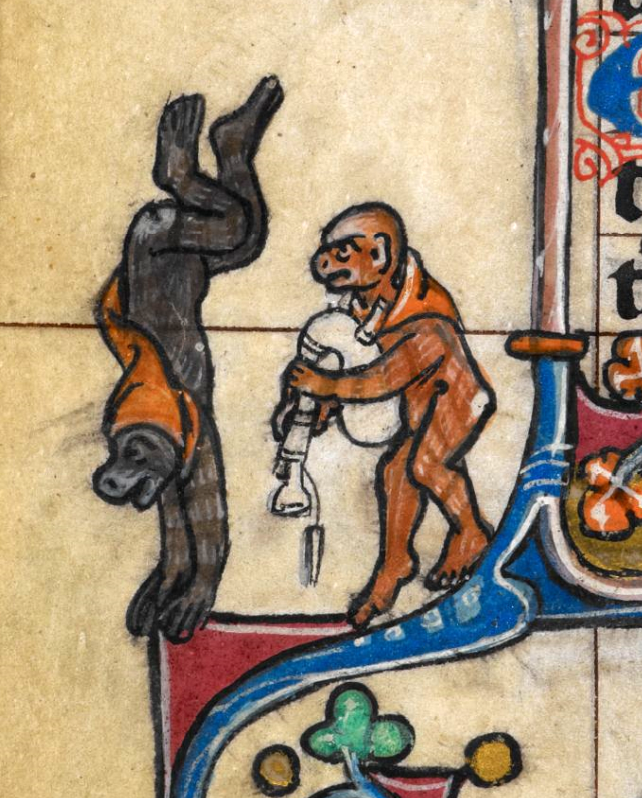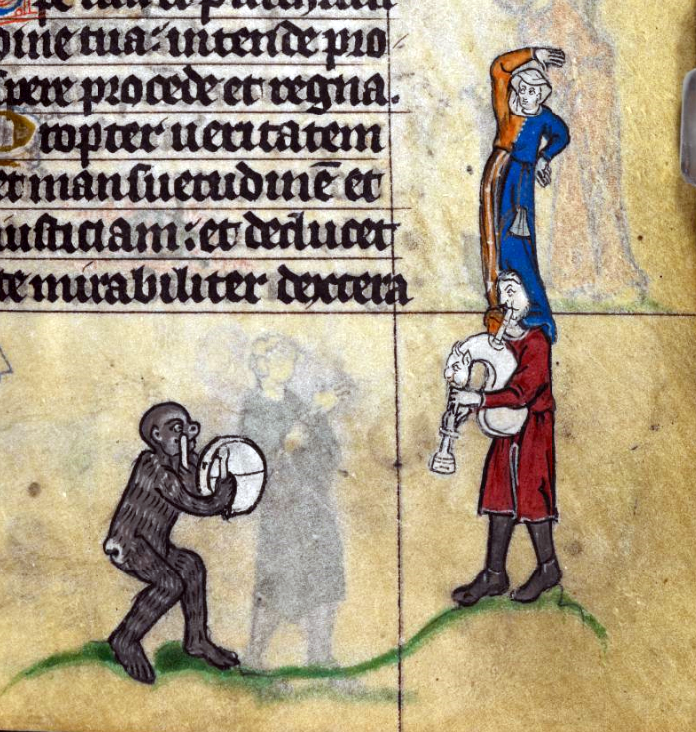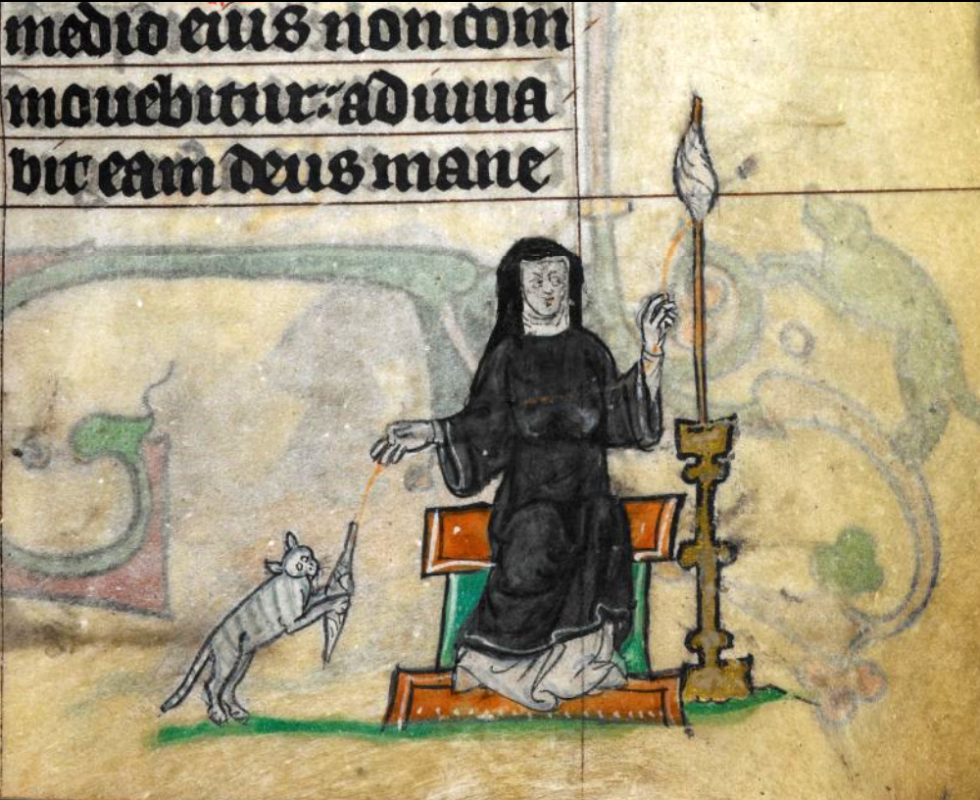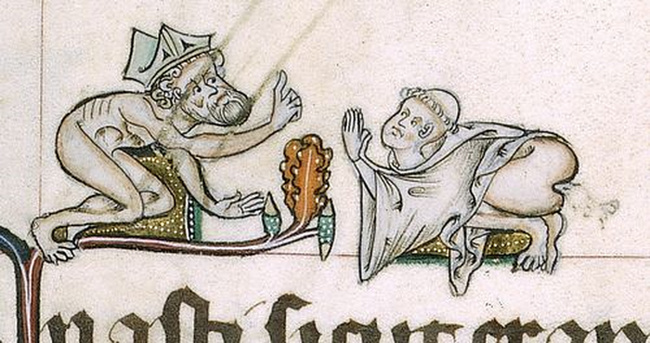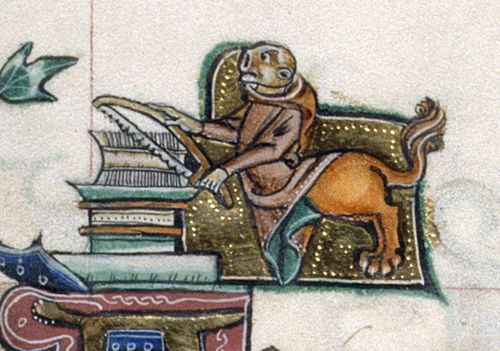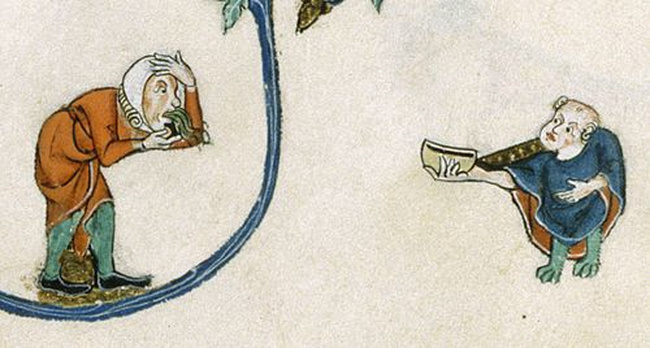It is naive to think that the fantasy of Hieronymus Bosch, even so much unique, arose "out of nothing", or originated spontaneously in a single eccentric head. All his subjects — people, animals, some other creatures — whether a learned locust, or a loving nun pig, or a dragon with horse legs and the body of a roasted turkey, or a bird in a cardinal’s cassock, with a funnel on its head and skating — they, of course, belong to Bosch and can be certified by his copyright. But this type of thinking itself, in which people not only behave strangely or obscenely, but also act like animals in life, was by no means generated by Bosch. Long before Bosch, it had already existed in the margins of medieval manuscripts (marginalia).
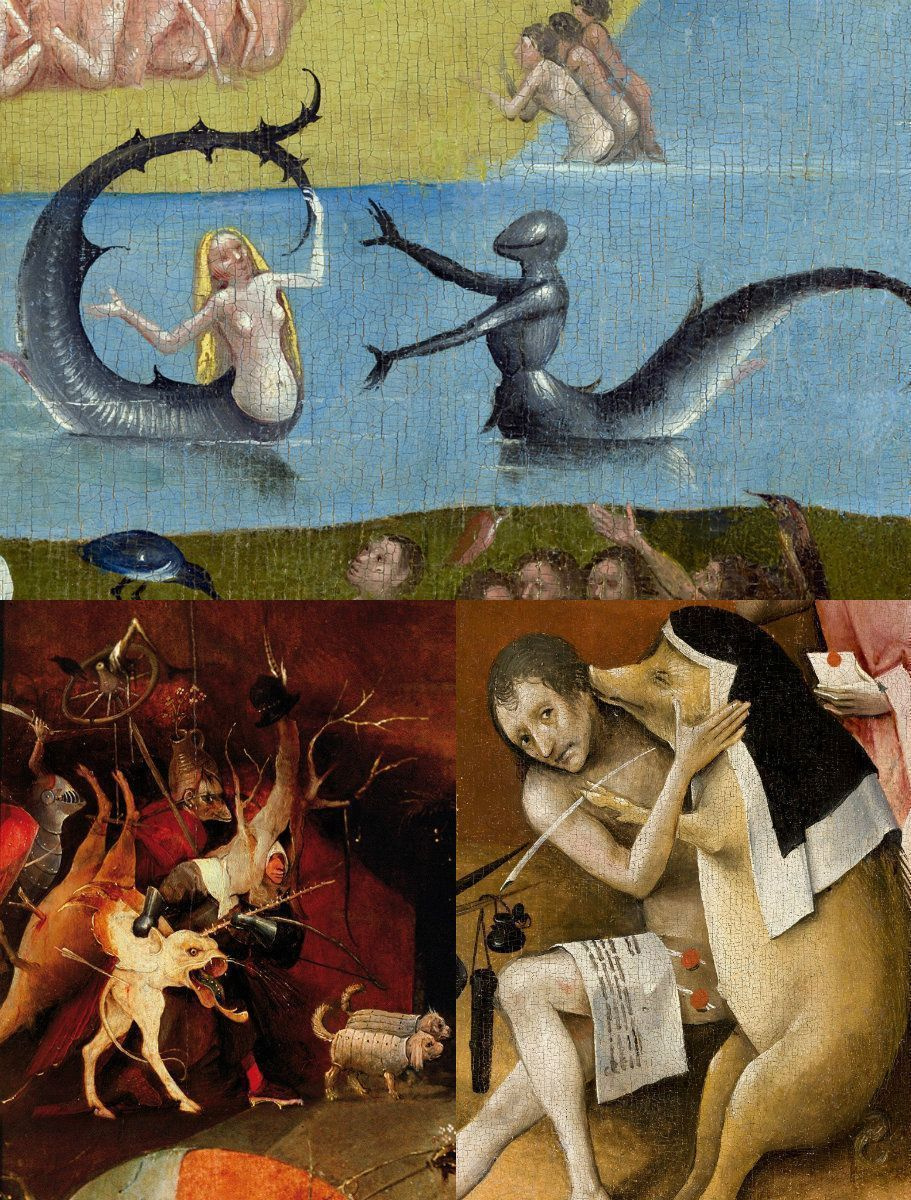
Anyone who flips through the liturgical manuscripts of the 11—16th centuries for the first time (fortunately, now such an opportunity has appeared in digital libraries), risks experiencing a cultural shock. Right on the pages of books of hours, missal books and psalteries, valiant knights fight with snails, ladies courtly communicate with monkeys and fall into the arms of dragons, hares play music on organs, and bears play bagpipes, while people behave like pure animals, demonstrating those physiological acts that are usually hidden from human eyes.
Moreover, all sorts of crazy hybrids of people with horses, scorpions, birds, snails and other amphibians and artiodactyls, as well as "frankensteins" whose legs are sewn to the head without a body, and an extra face (often more beautiful than the main one!) has grown on the bottom are waiting for you.
The marginals below are taken from the Maastricht Book of Hours — a Dutch manuscript liturgical book of the first half of the 14th century, that is, theoretically (taking into account factors of both time and space), Bosch could even be familiar with it.
Moreover, all sorts of crazy hybrids of people with horses, scorpions, birds, snails and other amphibians and artiodactyls, as well as "frankensteins" whose legs are sewn to the head without a body, and an extra face (often more beautiful than the main one!) has grown on the bottom are waiting for you.
The marginals below are taken from the Maastricht Book of Hours — a Dutch manuscript liturgical book of the first half of the 14th century, that is, theoretically (taking into account factors of both time and space), Bosch could even be familiar with it.


How is this even possible?
Here is one of the witty explanations for the appearance of such strange and sometimes obscene pictures in the margins of sacred texts.Imagine that you are a monk of the 9th, 11th or 13th century, and your obedience, which you will perform day after day, year after year, for decades (unless the plague or consumption does not teleport you to the outworld earlier) is a painstaking rewriting of liturgical texts. Month after month, year after year — for decades! With only breaks for Holy Mass and a meagre meal. Gutenberg would not invent printing soon, or maybe he would not invent it at all, how do you know it in your 12th century? Humanity has not yet bothered with air conditioning, ergonomic chairs or a table lamp. Your cell, depending on the season, is stuffy or chilly. And regardless of the season, it is semi-dark. And here you are, hunched over by a candle stub, and write letter by letter, vignette after vignette.
Gorgeous black characters are born from your pen. From year to year, your handwriting becomes more and more perfected, and your drawings more filigree. But there is no escape from the "burnout syndrome" (or the machinations of the devil): monotonous activity requires relaxation. Some kind of outburst, something that would interrupt the routine, e. g. cause an explosion of laughter to cause the beneficial surge of oxygen to the brain. And then you draw a curious figure in the margins of your manuscript (just like someone 7 centuries after you would draw faces in his notebook at a boring meeting) and imagine that this is your little hello to someone who will read the book many years later; the book, on the rewriting of which you have sacrificed your only God-given life.

Drawings in the margins of the Book of Hours, created in England at the end of the 13th century.
Scientists have found that the main artist who illuminated this book (his name, however, did not come down to us) also designed the psalter kept at Trinity College, Cambridge. But we don’t know whether the half-man-half-crane who laid the egg, as well as the human figure picking in the nose and here and there — the real emblem of procrastination — belong to the same master or to one of his "subordinates". Looking at these weird pictures, you find a new way to understand the phrase from the annotation to the English Book of Hours that "the illustrations in the book are notable for their vivid imagery".
.
Scientists have found that the main artist who illuminated this book (his name, however, did not come down to us) also designed the psalter kept at Trinity College, Cambridge. But we don’t know whether the half-man-half-crane who laid the egg, as well as the human figure picking in the nose and here and there — the real emblem of procrastination — belong to the same master or to one of his "subordinates". Looking at these weird pictures, you find a new way to understand the phrase from the annotation to the English Book of Hours that "the illustrations in the book are notable for their vivid imagery".
.
Beast people from the Book of Hours of Simon de Varie
Medieval culture supossed creating chimeras, ingeniously combining parts of the human body and various animals in one creature. It depicted not only ancient harpies — evil monsters with a female head, lion’s claws and wings of a bird of prey. Medieval artists were rather strange geneticists: they managed to interbreed man with artiodactyl, lion with seahorse, or bird with monkey without decoding the DNA code.
Marginalia from The Book of Hours of Simon de Varie. It is believed that most of the design of this manuscript belongs to the great Jean Fouquet (c. 1420—1480), who is considered the most prominent French artist of the 15th century.

And this is how a whole page of The Book of Hours of Simon de Varie looks like. One of the biblical scenes is set against a solid background of colourful vignette pattern. The pelican below is most likely a symbol of Christ, but oh my Lord, what does a man-mermaid on dragon’s legs symbolize?!
For the sake of fairness, note that not only for us, modern viewers, viewing such images causes cognitive dissonance. Back in the 12th century, the Catholic theologian and mystic Bernard of Clairvaux was surprised and indignant no less when he asked:
"In monasteries, before the eyes of the reading brothers, what does this ridiculous monstrosity, this strange ugly beauty, or beautiful ugliness do? What are these unclean monkeys doing here, these wild lions, these ugly centaurs, these half-human half-beasts, these spotted tigers, these fighting warriors, these hunters who blow their horns? You will see many bodies with one head or, conversely, one body with many heads. Here, a four-legged one has a snake’s tail, there a fish with a head of a four-legged animal. Here is the beast: a horse from the front, and a half-goose from the back. But the horned animal turns into a horse to its back. The variety of different forms is so great and wonderful everywhere that it is more pleasant to read statues than books, marvelling at them all day instead of meditating on the laws of God all day."
"In monasteries, before the eyes of the reading brothers, what does this ridiculous monstrosity, this strange ugly beauty, or beautiful ugliness do? What are these unclean monkeys doing here, these wild lions, these ugly centaurs, these half-human half-beasts, these spotted tigers, these fighting warriors, these hunters who blow their horns? You will see many bodies with one head or, conversely, one body with many heads. Here, a four-legged one has a snake’s tail, there a fish with a head of a four-legged animal. Here is the beast: a horse from the front, and a half-goose from the back. But the horned animal turns into a horse to its back. The variety of different forms is so great and wonderful everywhere that it is more pleasant to read statues than books, marvelling at them all day instead of meditating on the laws of God all day."
Warlike snails are in trend!
In the handwritten marginalia of the Middle Ages, as in any design, there were current trends. For example, somewhere between 1290 and 1330 the letter-free space of manuscripts was filled with warlike snails in England, France and Flanders at the same time.
The ferocious gastropods were not afraid to attack the valiant armed knights, and one even had to protect his beautiful lady from the brutal mollusk.

But why does a knight stoop to fight a snail? Perhaps because he is a donkey?


Medievalist Elizabeth Moore Hunt believes that war snails are a brutal satire of shredded knights who tremble even at the sight of a snail. The snail can also symbolize low social status. Noble knights now fight with those who are far from their equal. And snails, meanwhile, are slowly climbing up the social ladder.
And while wise theologians eloquently argued that the snail is a symbol of the resurrection of Christ (in fact, in medieval images any animal can indicate it), ordinary scribes of the Gospels and Psalms merrily crossbreeded snail with deer or cat.
Shocking marginalia in the Gorleston Psalter
One of the most scandalous manuscripts in terms of weird pictures is The Gorleston Psalter — a Psalter from the city of Gorleston, located in the east of England in Norfolk. Medieval ideas about decency were surely significantly different from ours. But even for them, vomiting, fart, shamelessly sticking out tongue, which is equated with a phallus in medieval semiotics, and kissing the butt (all this is placed next to the texts of psalms and litanies) was too much.Much effort has been made to find a "decent" justification for the fact why there are so many obscene drawings on the pages of the Gorleston Book of Psalms.
Blasphemous, erotic or scatological motives have long been a source of concern for scientists. They composed so many theories! Some said that the scribe drew what God (or the devil) would put on his soul because of the "fear of an empty sheet" — a common phobia among people of this profession. Others argued that the drawings are arbitrary and, in fact, have nothing to do with the text, and therefore they should simply be ignored. Still others wrote that in medieval culture, there was simply no impassable border between the sacred (divine) and the profane (base). Others argued that the drawings of the Gorleston Psalter were the work of vandals who wanted to undermine the sacred nature of the Old Testament texts from within.
Among the marginalia of the Gorleston Psalter, there are a number of ordinary everyday scenes typical of 14th century England, but they are in the minority. Basically, these are images of animals that act like people, and people who discover their animal nature.


Essentially, those who got acquainted with pictures from the Maastricht Book of Hours or the Gorleston Psalter wouldn’t consider the work by Hieronymus Bosch shocking any longer.
The title illustration: fragments of Hieronymus Bosch’s triptychs "The Garden of Earthly Delights" and "The Temptation of St. Anthony".
Author: Anna Vchorashnia
Author: Anna Vchorashnia






